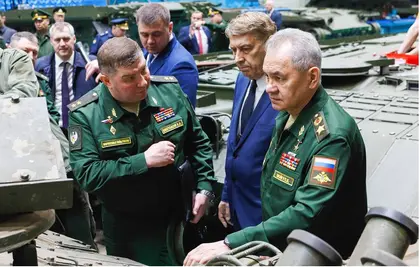Russia’s Defense Ministry reported on Friday that Russian Defense Minister Sergey Shoigu had visited the Omsktransmash tank production plant to assess whether it was implementing the defense procurement plan he gave them in June last year.
This included increased production of T-80BVM tanks, conversion of T-72 chassis into TOS-1A Solntsepyok heavy flamethrower systems and add-on armor for retrofitting to tanks deployed to Ukraine.
JOIN US ON TELEGRAM
Follow our coverage of the war on the @Kyivpost_official.
According to the state news agency TASS, Shoigu inspected a new batch of tanks the enterprise had prepared for their delivery to the so-called Ukraine “special military operation.”
A spokesperson for the ministry said the enterprise had been conducting trials into methods of creating additional protection for its tanks and said: “The head of the enterprise reported to Army General Sergey Shoigu that pursuant to his instruction the armor’s protection had been enhanced before its delivery to the special operation area.”
It reported Shoigu as saying the trials were successful and it was now necessary to “build up the pace of production.”
Following his visit to the shop floor, Shoigu held a meeting with enterprise management and representatives of the Defense, Industry and Trade Ministries where he said the plant was implementing the defense procurement plan in full and successfully fulfilling the instructions issued during the previous inspection.

Despite Kremlin Denials Satellite Images Suggest Russia Might Pull Out of Syria
“The enterprise has resolved the issues related to the production and delivery of new high-capacity engines. It has launched the production of new heavy flamethrower systems. It has fulfilled the tasks of providing tanks with extra armor against unmanned aerial vehicles of various categories and additional protection of sighting systems,” Shoigu said.
The ministry spokesperson said the factory had boosted the output of TOS-1A Solntsepyok heavy flamethrower systems by 150 percent by expanding its production capacities, switching to round-the-clock operation, and increasing the size of its workforce.
It said that Shoigu had further stressed the need to increase the supplies of enhanced tank protection kits for units in Ukraine saying, “It is necessary to considerably increase the production of additional protection sets for vehicles engaged in combat actions and send them to the repair and maintenance brigades on the battlefield.”
As so often with these visits it is difficult to confirm the reality of what the enterprise tells Shoigu, and what he and his staff then report to the Kremlin. He has been engaged in increasing numbers of visits to Russian vehicle, equipment, and ammunition manufacturers since the beginning of 2023 as Russian losses in Ukraine have reached critical levels.
On his visits, Shoigu has demanded that all factories increase the levels and quality of production and is inevitably assured that all is well. He in turn paints a picture of targets being reached and exceeded to Putin and Russian media.
In November he was told by the head of the Rostec state arms corporation that tank production had increased sevenfold in 2023 which, if true, meant Russian industry had supplied the army with more than 2,000 tanks of various types.
The Swedish FOI research institute said the sevenfold figure only referred to new builds which it estimated as 210 compared with an average of 30 per year before the full-scale invasion. Its estimate was less than 600 tanks had been added to the inventory in 2023, the majority of which were tanks removed from long-term storage.
In February Shoigu claimed that the Russian armed forces' holdings of tanks, ammunition, and drones, as well as the quality of protection for armored vehicles, had increased since before the war.
In an interview with TASS he claimed: “The Russian Federation's troops now have 17 times more UAVs, 17.5 times more ammunition, and six times more tanks. This allows us to look ahead with confidence...” But the reality is somewhat different.
Only a month earlier Shoigu had complained during a visit to Uraltransmash that production deadlines for artillery systems were being missed. He angrily told the head of the plant:
“Listen, stop fooling around here, guys. We got busy with this in 2022. We should have these machines operating at full capacity in 2023, but with you everything is so calm, so to speak, good.”
You can also highlight the text and press Ctrl + Enter






